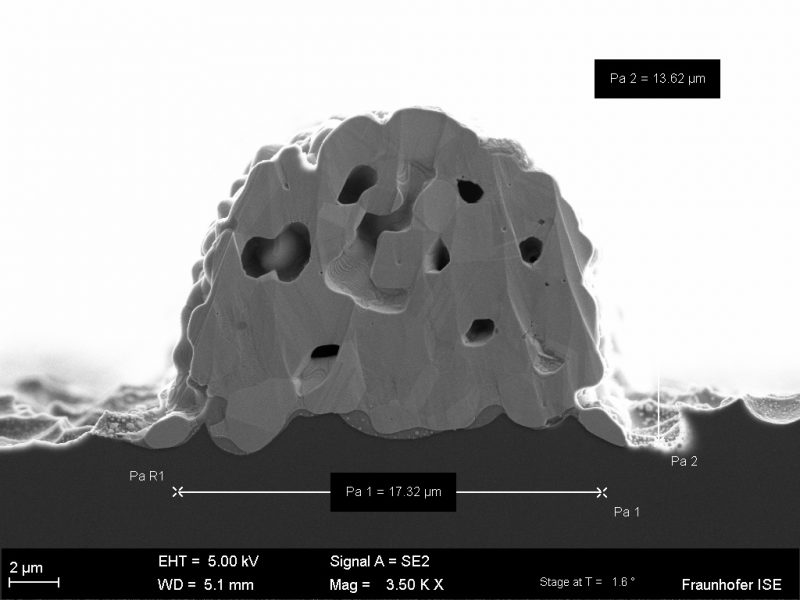PVTIME – Solar power is the most cost-effective form of energy worldwide, thanks to the many significant research contributions continuously made up to today. A decisive factor here is resource-saving production technology, which plays an important role along with increasing efficiency. HighLine Technology GmbH is the most recent Fraunhofer ISE spin-off company. The Freiburg-based start-up aims to commercialize a new process which was developed at the institute, whereby a contactless dispensing process is used to apply front metal contacts onto solar cells. This process not only saves resources but also increases the electricity yield and the potential for cost reductions. Applications also include production processes outside the field of photovoltaics.

Cross-section of a silver finger lines (17µm width) produced by dispensing technology on a silicon solar cell.
The expertise behind the young company HighLine Technology is an accumulation of ten years’ research work on dispensing processes for silicon solar cell metallization at the Fraunhofer Institute for Solar Energy Systems ISE. During this period in which a multi-nozzle dispensing print head was developed, expansive knowledge was acquired on printing pastes and processes. The developed technology can easily be integrated into conventional production lines for silicon solar cells, replacing the screen printing process normally used for the front-side metal contacts. In addition, the material consumption of the costly silver is reduced by around 20%. The front-side contacts produced by the process are thinner, exposing a larger semiconductor surface to the sunlight. This increases the electricity output and thus the efficiency by approximately 1% relative. The contactless process promises a lower reject rate when using thinner silicon wafers, and the inline printing process will perspectively increase the throughput significantly as compared to the conventional screen printing process used by industry today. With the new process, it is also possible to optimize other production steps used in solar cell manufacturing.
Not Only Making Solar Cell Production More Sustainable
“Our main focus is currently on reducing material consumption in the photovoltaic industry,” says Dr. Maximilian Pospischil, Managing Director and one of the founders of HighLine Technology. He adds: “Our aim is to bring the highly efficient parallel dispensing technology which was developed at Fraunhofer ISE to the market. Along the way, we are continuing to work closely with Fraunhofer ISE’s Photovoltaic Technology Evaluation Center PV-TEC. Besides the photovoltaic industry, our dispensing technology is attractive for other industrial production processes. Our service offer includes accompanying companies from equipment manufacturing, through the process integration up to the application”.
Comparable to Printing with a Sophisticated Toothpaste Tube
In the dispensing technology, the materials are pressed through the many miniscule nozzles of highly parallel print heads onto the front solar cell surface via a contactless printing process. As opposed to a toothpaste tube, however, the PV production developers use nozzles with diameters which are only half as thick as a human hair (approx. 20 µm). The tiny nozzles work in parallel to produce the desired structures at high throughput.
“We are very pleased to welcome HighLine Technology as a new customer of our PV-TEC,” says Dr. Ralf Preu, Head of Photovoltaic Production Technology at Fraunhofer ISE. “The unique infrastructure of PV-TEC makes it possible for us to cooperate with start-ups in an excellent way, enabling us to adapt new technology developments to specifically meet the market needs.”
HighLine Technology GmbH received funding from the EXIST Transfer of Research program of the Federal Ministry of Economic Affairs and Energy BMWi and is also financed by the Fraunhofer Technologie Transfer Fonds GmbH FTTF among others.
Fraunhofer not only distinguishes itself through its industry-related research but also through technology transfer in the form of its spin-off companies. To date Fraunhofer ISE has helped create more than a dozen companies that bring the technologies and methods developed at the institute to the market.










